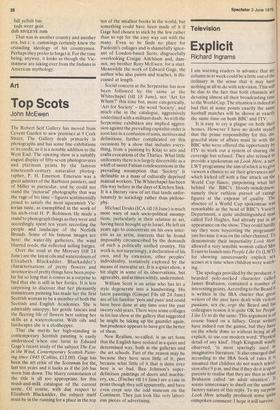Art
Top Scots
John McEwen
The Robert Self Gallery has moved from Covent Garden to new premises at 9 Cork Street, The Gallery deals primarily in photographs and has some fine exhibitions to its credit, so it is a notable addition to the West End. The opening show is a suitably august display of fifty-seven photogravures and platinum prints by the famous nineteenth-century naturalist photog rapher, P. H. Emerson. Emerson was a great admirer of the Barbizon painters, and
of Millet in particular, and he could not stand the 'pictorial' photography that was the rage of his time — figures sentimentally posed to satisfy the most squeamish Victorian taste, as exemplified in the work of his arch—rival H. P. Robinson. He made a stand to photograph things as they were and accordingly spent ten years recording the people and landscape of the Norfolk Broads. Some of his famous images are here: the water-lily gatherers, the wind blurred reeds, the reflected sailing barges.
Over the road at the Mercury (till 24 June) are the latest oils and watercolours of Elizabeth Blackadder. Blackaddcr's characterisations of pretty flowers and inventories of pretty things have been popular for so long that it comes as a surprise to find that she is still in her forties. It is less surprising to discover that her pleasantly mainstream painting has made her the first Scottish woman to be a member of both the Scottish and English Academies. She is admirably unsoppy, her gentle fancies and the fleeting life of flowers best suiting her skills as a watercolourist. With oils and landscapes she is a clodhopper.
That she merits her high-standing in contemporary Scottish painting is easily understood when one turns to Edward Gage's recent study of the subject The Eye in the Wind, Contemporary Scottish Painting since 1945 (Collins, f12.00). Gage has been the art critic of the Scotsman for the last ten years and it looks as if the job has worn him down. The blurry connotation of the title is all too appropriate for this mush-and-milk catalogue of the current scene. Of course, with due respect to Elizabeth Blackadder, the subject itself must be in the running for a place in the top
ten of the smallest books in the world, but something could have been made of it if Gage had chosen to stick by the few rather than to opt for the easy way out with the many. Even so he finds no place for Paolozzi's collages and is shamefully ignorant of London-based Scots, disgracefully overlooking Craigie Aitchison and, dammit, my brother Rory McEwen, for a start. Meanwhile the work of Edward Gage, the author who also paints and teaches, is discussed at length.
Social concern at the Serpentine has now been followed by the same at the Whitechapel (till 18 June), not 'Art for Whom?' this time but, more categorically, 'Art for Society' — the word 'Society', and much else in the catalogue, aggressively underlined with a militant daub. As with the Serpentine exhibition any implied aggression against the prevailing capitalist order is soon lost in a confusion of aims, motives and definitions, further complicated on this occasions by a show that includes everything, from a painting by Kitaj to arts and crafts evocations of the Thirties. What little uniformity there is is largely discernible as a whiff of sweet Fabian condescensions in the prevailing assumption that 'Society' is definable as a mass of culturally deprived manual workers. The Whitechapel has been this way before in the days of Kitchen Sink. It is a literary view of art that tends unfortunately to sociology rather than philosophy.
Michael Druks (ICA till 18 June) is much more wary of such socio-political assumptions, particularly in their relation to art, having been brought up in Israel. He left six years ago to concentrate on his own interests as an artist, interests that he found impossibly circumscribed by the demands of such a politically unified country. His work is, not surprisingly, a declaration of his own, and by extension, other peoples' individuality, tentatively explored by the means of surrealist art. It is a quiet show, a bit slight in some of its observations, but agreeably, and at times wittily, understated.
William Scott is an artist who has let a style degenerate into a handwriting. His latest paintings (Gimpel Fils till 24 June) are of his familiar 'pots and pans' and could have been done at any time over the past twenty odd years. There were some collages in his last show at the gallery that suggested he might be taking up the gauntlet again, but prudence appears to have got the better of them.
New Realism, so-called, is an art form that the English have resisted in a quiet and determined way, both in the galleries and the art schools. Part of the reason may be because they have seen little of it, part because what little of it that is done over here is so bad. Ben Johnson's super definition paintings of doors and machinery, etc., (Fischer till 14 June) are a case in point though they sell apparently, and have even crept into the odd museum on the Continent. They just look like very laborious pieces of advertising.


































 Previous page
Previous page